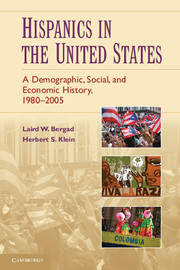Book contents
- Frontmatter
- Contents
- List of Graphs, Tables, and Maps
- Introduction
- 1 Immigration to the United States to 1980
- 2 The Hispanic Population to 1980
- 3 Population Growth and Dispersion, 1980–2005
- 4 The Demography of the Hispanic Population
- 5 Wealth and Poverty
- 6 Educational Attainment
- 7 Citizenship, the Latino Electorate, and Voter Participation
- 8 Occupational Structures, Employment, and Unemployment
- 9 English Language Abilities and Domestic Usage
- 10 Hispanic Business Ownership
- 11 Race
- 12 Endogamous and Exogamous Marriage Patterns among Latino Household Heads
- 13 Conclusion
- Bibliography
- Index
- References
2 - The Hispanic Population to 1980
Published online by Cambridge University Press: 05 June 2012
- Frontmatter
- Contents
- List of Graphs, Tables, and Maps
- Introduction
- 1 Immigration to the United States to 1980
- 2 The Hispanic Population to 1980
- 3 Population Growth and Dispersion, 1980–2005
- 4 The Demography of the Hispanic Population
- 5 Wealth and Poverty
- 6 Educational Attainment
- 7 Citizenship, the Latino Electorate, and Voter Participation
- 8 Occupational Structures, Employment, and Unemployment
- 9 English Language Abilities and Domestic Usage
- 10 Hispanic Business Ownership
- 11 Race
- 12 Endogamous and Exogamous Marriage Patterns among Latino Household Heads
- 13 Conclusion
- Bibliography
- Index
- References
Summary
The reform of the quota system in 1965 influenced the flow of immigration to the United States, allowing low-wage and high-fertility countries and regions to begin supplying migrants to the expanding American labor market. The European countries that had been the previous sources of migration to the United States had recovered from the devastation of World War II by the late 1960s, and with their declining fertility, ensuing low population growth rates, and increasingly industrialized urban economies, they were able to absorb most, if not all, of their younger workers entering labor markets. Some European nations even became net importers of foreign labor and in many cases there was labor migration to nearby European countries when higher wages prevailed. But in Latin America and Asia, the beginning of the demographic transition in the postwar period, which was characterized by rapidly declining mortality rates but the maintenance of high pretransition fertility rates, lead to extraordinary rates of natural population growth by historical standards. These expanding populations were surpassing the ability of the local economies to absorb them into their labor markets. The continuing growth of the U.S. economy, now the world's largest, and the end of immigration restrictions in terms of national origins, opened the United States to a new wave of immigration from Asia and Latin America and the Caribbean.
Both regions were sources of migrants to the United States from the mid 19th century on, although the number of migrants was relatively small. There had also been immigrants arriving from the former Spanish colonies of Cuba and Puerto Rico beginning as far back as the early 19th century when economic and political connections were forged between the Hispanic Caribbean and the United States because of growing sugar imports from these islands, although this migration was small scale. Almost all settled in the East. New York and Florida were the principal states where Cuban and Puerto Rican communities first emerged, and a Cuban presence was established in Louisiana as well because of the local sugar industry. The 1898 U.S. intervention in the Cuban War for Independence through a full-scale invasion of Cuba, the subsequent military occupation of Puerto Rico in the same year, and that island's annexation to the United States as an “unincorporated territory” in 1900, created new political conditions for migration. During the early 20th century Puerto Ricans migrated to Hawaii, recruited as laborers for the sugar industry, and small Puerto Rican communities evolved in New York City, in Red Hook, Brooklyn, and later in East Harlem, which came to be known as El Barrio. After 1898, the Cuban presence in Tampa, Florida, also increased, building upon a foundation that was established much earlier during the 19th century in the cigar-manufacturing industry.
- Type
- Chapter
- Information
- Hispanics in the United StatesA Demographic, Social, and Economic History, 1980–2005, pp. 36 - 62Publisher: Cambridge University PressPrint publication year: 2010



